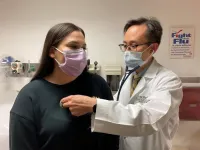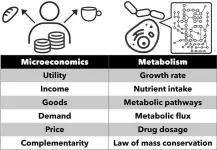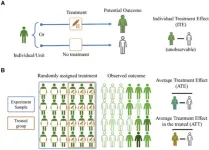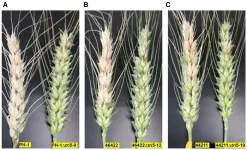(Press-News.org) Two pathologies drive the progression of Alzheimer’s disease. Early on, amyloid beta plaques lead the way, but around the time cognitive symptoms arise, tau tangles take over as the driving force and cognition steadily declines. Tracking the course of the disease in individual patients has been challenging because there’s been no easy way to measure tau tangles in the brain.
But now, researchers at Washington University School of Medicine in St. Louis and Lund University in Lund, Sweden, have identified a form of tau that could serve as a marker to track Alzheimer’s progression. The marker also could be used by Alzheimer’s drug developers to assess whether investigational tau-based drugs – the next frontier in Alzheimer’s drug development – are effective against the disease. Such drugs theoretically would benefit people in later stages of the disease, when tau tangles play a crucial role.
By studying 667 people in Sweden and the U.S. at various stages of Alzheimer’s disease, the researchers discovered in the cerebrospinal fluid that levels of a specific form of tau — known as microtubule binding region (MTBR)-tau243 — track with the amount of damaging tau tangles in the brain and with the degree of cognitive decline.
The findings, published July 13 in Nature Medicine, are a major step toward a better approach to diagnosing and staging Alzheimer’s disease. A test based on MTBR-tau243 could speed up drug development by providing a relatively simple and inexpensive way to identify and monitor participants in clinical trials and assess whether the experimental therapies, including tau-based drugs, can change the course of the disease.
“This discovery provides biomarkers to specifically track the progression of tau tangles, the major pathology that predicts dementia and cognition, which is something that hasn’t been within reach until now,” said co-senior author Randall J. Bateman, MD, the Charles F. and Joanne Knight Distinguished Professor of Neurology at Washington University. “These findings will help accelerate drug development for patients with symptoms of Alzheimer’s disease. We are also working on developing these biomarkers as a clinical test to stage individual patients and improve patient care.”
The gold standard for measuring tau tangles in the brain is the tau-positron emission tomography (tau-PET) brain scan, which costs thousands of dollars and requires expensive equipment and specialized expertise not available at most hospitals, making such scans impractical for patient care and costly for research studies.
In 2020, Bateman and Kanta Horie, PhD, a research associate professor of neurology and co-first author on the new paper, showed that levels of MTBR-tau243 in the cerebrospinal fluid reflect the amount of tau tangles in the brain. In this new study, Bateman and Horie teamed up with Lund University’s Oskar Hansson, MD, PhD, a professor of neurology and study co-senior author, and Gemma Salvadó, PhD, a postdoctoral researcher and co-first author, to extend the analysis to a larger number of people and to compare MTBR-tau243 to other tau biomarkers.
The researchers analyzed data from people who volunteered for Alzheimer’s research studies through the Biomarkers For Identifying Neurodegenerative Disorders Early and Reliably (BioFINDER)-2 (448 people) study in southern Sweden or the Knight Alzheimer Disease Research Center (219 people) in St. Louis. The average age of participants was 71, and the group included healthy people as well as people at all stages of disease, ranging from those with some amyloid in their brains but no cognitive symptoms, to those with extensive amyloid and tau in their brains and a diagnosis of dementia. The researchers compared cognitive function with levels of various forms of tau in the cerebrospinal fluid and with levels of amyloid and tau in the brain, as measured by amyloid and tau PET scans.
Levels of MTBR-tau243 in the cerebrospinal fluid correlated strongly with brain tau tangle levels and cognitive function. As MTBR-tau243 levels went up, tau levels in the brain also went up, and scores on cognitive tests went down. In contrast, levels of another form of tau in the cerebrospinal fluid, phosphorylated tau, tracked mainly with brain amyloid levels but not with brain tau levels or cognitive function.
“To accurately diagnose Alzheimer’s disease in patients with cognitive symptoms, we need biomarker-based evidence of both amyloid beta plaques and tau tangle pathology,” Hansson said. “With this new biomarker, representing tau pathology, we can do this using a single cerebrospinal fluid sample. This has the potential to clearly improve the diagnostic as well as prognostic work-up of Alzheimer’s worldwide. We hope that we soon can do the same using a simple blood test.”
By combining the two forms of tau in the cerebrospinal fluid — phosphorylated tau and MTBR-tau243 — the researchers were able to predict cognitive function almost as well as by using tau-PET.
“A combination of phosphorylated tau and MTBR-tau243 in the cerebrospinal fluid reveals not only whether an individual has Alzheimer’s disease but identifies the stage of illness – from presymptomatic disease to full-blown dementia,” Horie said.
By taking repeated samples of cerebrospinal fluid, researchers could track the progression of the disease and determine the effect of interventions such as experimental anti-tau therapeutics on the disease trajectory.
“In late stages of Alzheimer’s disease, the effectiveness of anti-amyloid therapies may weaken because amyloid is no longer playing a major role in driving the disease,” Horie said. “But that’s when tau becomes relevant. By stopping the tau pathology, we may be able to stop further cognitive decline including memory loss. By maintaining individuals at the level of mild cognitive impairment and preventing further cognitive decline, we can help people maintain a good quality of life. That’s what we’re working toward.”
END
Tau-based biomarker tracks Alzheimer’s progression
Novel marker found in cerebrospinal fluid also could speed development of Alzheimer’s drugs
2023-07-13
ELSE PRESS RELEASES FROM THIS DATE:
Engineering dual carriageways for signals
2023-07-13
Routing signals and isolating them against noise and back-reflections are essential in many practical situations in classical communication as well as in quantum processing. In a theory-experimental collaboration, a team led by Andreas Nunnenkamp from the University of Vienna and Ewold Verhagen based at the research institute AMOLF in Amsterdam has achieved unidirectional transport of signals in pairs of "one-way streets". This research published in Nature Physics opens up new possibilities for more flexible signaling devices.
Devices that allow ...
In historic procedure, donor liver protects heart transplant
2023-07-13
Doctors in Seattle are reporting a history-making case in which a patient received two donor organs, a liver and a heart, to prevent the extreme likelihood that her body would reject a donor heart transplanted alone. In this innovative case, the organ recipient’s own healthy liver was transplanted, domino-like, into a second patient who had advanced liver disease.
The dual-organ recipient, Adriana Rodriguez, 31, of Bellingham, Washington, has recovered well since the Jan. 14, 2023, procedures, said Dr. Shin Lin, a cardiologist ...
Red pill or blue pill? The critical decision to control the superbugs
2023-07-13
Researchers from Tokyo Medical and Dental University (TMDU) investigate a pharmacist-led intervention to optimize the oral antimicrobial prescriptions in dental setting
Tokyo, Japan - The battle to stop the increase of superbugs in hospitals has been an ongoing struggle for healthcare professionals. Dentists are currently facing a medical challenge that determines the faith of antimicrobial resistance in healthcare settings. To choose the “red pill” means to embrace the painful truth that bacteria are acquiring resistance to many antimicrobials. Meanwhile, the “blue pill” creates ...
The economic life of cells
2023-07-13
A team from the University of Tokyo has combined economic theory with biology to understand how natural systems respond to change. The researchers noticed a similarity between consumers’ shopping behavior and the behavior of metabolic systems, which convert food into energy in our bodies. The team focused on predicting how different metabolic systems might respond to environmental change by using an economic tool called the Slutsky equation. Their calculations indicated that very different metabolic ...
Researchers propose strategy for improving NASICON-type cathode performance
2023-07-13
Manganese-rich NASICON-type materials have attracted widespread attention for developing advanced polyanionic cathodes, primarily driven by their abundant reserves, promising cycling performance, and potentially high operating voltage.
Unfortunately, their charge/discharge profiles exhibit significant voltage hysteresis, which leads to a limited reversible capacity, thereby preventing their application.
Now, however, the situation may be changing due to research by scientists at the Institute of Process Engineering (IPE) and the Institute of Physics of the Chinese Academy of Sciences. They recently identified ...
Drexel’s titanium oxide material lets sunlight drive green hydrogen production
2023-07-13
Clean energy plans, including the U.S. Infrastructure Investment Act’s “Clean Hydrogen Road Map,” are counting on hydrogen as a fuel of the future. But current hydrogen separation technology is still falling short of efficiency and sustainability goals. As part of ongoing efforts to develop materials that could enable alternative energy sources, researchers in Drexel University’s College of Engineering have produced a titanium oxide nanofilament material that can harness sunlight to unlock the ubiquitous molecule’s potential as a fuel source.
The discovery offers an alternative ...
Advancing causal inference in clinical neuroscience research: a call for clarity
2023-07-13
A Perspective published in Volume 3 of the journal Psychoradiology, researchers from Shanghai Jiao Tong University confronted these challenges and advocates for more clarity and transparency in causal analyses. The review distinguishes between traditional statistical analysis and causal inference, highlighting the need for specific causal assumptions, like the Stable Unit Treatment Value Assumption (SUTVA).
Randomized controlled trials (RCTs) are considered the gold standard for estimating causal effects. The authors stress the importance of imitating RCTs in observational studies through quasi-experimental techniques, ...
Longevity biotech startup Gero demonstrates the power of quantum computing in drug design
2023-07-13
Gero, an AI-driven biotech focused on aging and longevity, has demonstrated the feasibility of applying quantum computing for drug design and generative chemistry, which now offers significant promise for the future of healthcare. The research, published in Scientific Reports, outlines how a hybrid quantum-classical machine-learning model was used to interface between classical and quantum computational devices with the goal of generating novel chemical structures for potential drugs — an industry first.
The research paper follows ...
Timing of turkey nesting may not shift with changing climate
2023-07-13
A new study suggests eastern wild turkeys in five southern U.S. states are unlikely to make meaningful changes in the timing of when they begin nesting, even under significant future climate change.
The findings suggest eastern wild turkeys (Meleagris gallopavo silvestris) could be vulnerable to shifts in climate, which could threaten the availability of their food sources, the amount of vegetation cover available to protect them from predators, and other factors.
“There are implications here for turkey populations ...
New toxin facilitates disease infection and spread in wheat
2023-07-13
Although wheat was among the first domesticated food crops, it remains a global dietary staple several millennia later. Grown on every continent except Antarctica, wheat is the second highest produced grain worldwide, with nearly 800,000 metric tons grown each year (Food and Agriculture Organization). However, a fungal pathogen named Fusarium graminearum causes the devastating disease Fusarium head blight (FHB) on wheat and contaminates grains with harmful toxins called trichothecenes. One such trichothecene, called deoxynivalenol (DON), is produced by most F. graminearum strains in the United States, and it is an essential virulence factor that increases the pathogen’s spread ...
LAST 30 PRESS RELEASES:
Severe weather is deadly for vulnerable older adults long after the storm ends, study finds
Expert panel highlights opportunities for improving cancer studies
Hearing aid prescriptions not associated with changes in memory and thinking
Seth Zippel selected for The Oceanography Society Early Career Award
Jeremy Horowitz selected for The Oceanography Society Early Career Award
Kennesaw State University’s Jerry Mack named Paul “Bear” Bryant Newcomer Coach of the Year
Ancient teeth are treasure troves of data on Iron Age lifestyles
Avocados may become easier to grow in India—but not if global emissions remain high
Pregnant women with IBD show heightened inflammation in vaginal mucosa
Underwater photos show seabirds, seals and fish interacting with a tidal turbine in Washington State
1 in 5 surveyed UK adults who have experienced the death of a pet report it as more distressing than experienced human deaths, with significant rates of prolonged grief disorder symptoms also being re
Polyester microfibers in soil negatively impact the development of cherry tomato plants in experiments, raising concerns over the potential effect of high levels of such contaminants
LGBTQ+ adults may be around twice as likely to be unemployed or to report workforce non-participation compared to heterosexual adults, per large representative Australian survey
Horses can smell fear: In experiments where horses smelled sweat from scared humans, they reacted to scary and sudden events with increased fear and reduced human interaction
New synaptic formation in adolescence challenges conventional views of brain development
Scientists identify target to treat devastating brain disease
Oliver Zielinski selected as Fellow of The Oceanography Society
Has progress stalled on gender equality at work?
Quantum simulator sheds light on how nature moves energy in systems like photosynthesis and solar conversion
Can a hashtag help prevent atrocities? Study shows social media can be a powerful tool
The American Ornithological Society (AOS) announces the winner of the 2025 Wesley Lanyon Award
Woolly rhino genome recovered from Ice Age wolf stomach
An earthquake on a chip: New tech could make smartphones smaller, faster
New research shows how AI tools are expanding individual capabilities while contracting scientific attention
A nanomaterial flex — MXene electrodes help OLED display technology shine, while bending and stretching
Global research team uncovers mechanism by which metabolites guide cellular decisions
Work hours, stress, and burnout among resident physicians
Quality of life of parents of premature infants
Should younger and older people receive different treatments for the same infection?
Scientists discover how fast the world’s deltas are sinking
[Press-News.org] Tau-based biomarker tracks Alzheimer’s progressionNovel marker found in cerebrospinal fluid also could speed development of Alzheimer’s drugs








